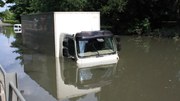
Increased flooding is likely to be one of the most serious effects from climate change in Europe over coming decades. Some of the conditions which may contribute to urban flooding are highlighted in a map from the European Environment Agency (EEA).

Road charges for heavy goods vehicles (HGVs or lorries) should reflect the varied health effects of traffic pollution in different European countries. This means charges should be much higher in some countries compared to others, according to analysis from the European Environment Agency (EEA).

Invasive alien species pose greater risks than previously thought for biodiversity, human health and economies, according to two new reports from the European Environment Agency (EEA).

Ozone pollution still exceeded target levels in Europe during summer 2012, but the number of exceedances of the alert threshold was lower than in any year since monitoring started in 1997. However, almost all EU Member States failed to keep levels of the pollutant within targets set to protect human health.

New technologies have sometimes had very harmful effects, but in many cases the early warning signs have been suppressed or ignored. The second volume of Late Lessons from Early Warnings investigates specific cases where danger signals have gone unheeded, in some cases leading to deaths, illness and environmental destruction.

Clean air will be the focus of EU environmental policy discussions throughout 2013, the Year of Air. The European Environment Agency (EEA) provides a wealth of information underpinning the review of air pollutant legislation.

Europe needs to work harder to protect its water resources from increasing pressures. This was one of the messages that emerged during 2012, ‘European Year of Water’. The European Environment Agency (EEA) also presented important findings in many other areas, including air, climate, biodiversity and chemicals.

Households and industry in the EU each cause approximately a quarter of energy-related greenhouse gas emissions, according to a new report by the European Environment Agency (EEA). The two sectors were largely responsible for the emissions increase in 2010, together leading to an additional 90 million tonnes of CO2 equivalent compared to 2009.

Belgian Professor Hans Bruyninckx has been selected by the EEA Management Board as the EEA Executive Director to take office from 1 June 2013. A formal offer of appointment will be made after all procedures have been finalised.

Data on land use provided by the European Environment Agency (EEA) is soon to be included in electronic maps used for navigation in mobile phones and other devices.


